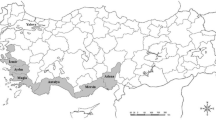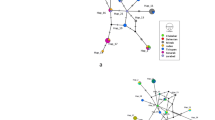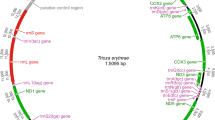Abstract
The olive fly (Bactrocera oleae) is the most important olive tree (Olea europaea) pest. In the Mediterranean basin, where 98 % of its main hosts are concentrated, it causes major agricultural losses, due to its negative effect on production and quality of both olive and olive oil. Previous phylogeographic analyses have established that Mediterranean olive fly populations are distinct from other Old World populations, but did not agree on the specific population substructure within this region. In order to achieve a higher resolution of the diversity of olive fly populations, particularly in Central and Western Mediterranean (home to 70 % of the world production), we comparatively analyzed a set of samples from Portugal in the context of published mitochondrial sequences across the species’ worldwide range. Strong evidence of population substructure was found in the Central and Western Mediterranean area, with two clearly separate phylogenetic branches. Together with previously published data, our results strongly support the existence of at least three distinct Mediterranean populations of the olive fly, raise the possibility of additional regional substructure and suggest specific avenues for future research. This knowledge can be instrumental in the development of better management and control strategies for a major pest of Mediterranean agriculture.

Similar content being viewed by others
References
Augustinos AA, Mamuris Z, Stratikopoulos EE, D’Amelio S, Zacharopoulou A, Mathiopoulos KD (2005) Microsatellite analysis of olive fly populations in the Mediterranean indicates a westward expansion of the species. Genetica 125(2–3):231–241. doi:10.1007/s10709-005-8692-y
Azevedo L, Suriano G, van Asch B, Harding RM, Amorim A (2006) Epistatic interactions: how strong in disease and evolution? Trends Genet 22(11):581–585. doi:10.1016/j.tig.2006.08.001
Azevedo L, Carneiro J, van Asch B, Moleirinho A, Pereira F, Amorim A (2009) Epistatic interactions modulate the evolution of mammalian mitochondrial respiratory complex components. BMC Genomics 10. doi:10.1186/1471-2164-10-266
Bandelt HJ, Forster P, Rohl A (1999) Median-joining networks for inferring intraspecific phylogenies. Mol Biol Evol 16(1):37–48
Drummond AJ, Ashton B, Buxton S, Cheung M, Cooper A, Duran C, Field M, Heled J, Kearse M, Markowitz S, Moir R, Stones-Havas S, Sturrock S, Thierer T, Wilson A (2010) Geneious v5.4. Available from http://www.geneious
Fletcher BS, Economopoulos AP (1976) Dispersal of normal and irradiated laboratory strains and wild strains of the olive fly Dacus oleae in an olive grove. Entomol Exp Appl 20:183–194
Goulielmos GN, Cosmidis N, Theodorakopoulou ME, Loukas M, Zouros E (2003) Tracing the history of an enzyme polymorphism: the case of alcohol dehydrogenase-2 (Adh-2) of the olive fruit fly Bactrocera oleae. Mol Biol Evol 20(3):293–306
Mavragani-Tsipidou P (2002) Genetic and cytogenetic analysis of the olive fruit fly Bactrocera oleae (Diptera: Tephritidae). Genetica 116(1):45–57
Montiel Bueno A, Jones O (2002) Alternative methods for controlling the olive fly, Bactrocera oleae, involving semiochemicals. In: Bulletin IW (ed) Use of pheromones and other semiochemicals in integrated production. IOBC/wprs Bulletin 25(9):1–11
Nardi F, Carapelli A, Dallai R, Frati F (2003) The mitochondrial genome of the olive fly Bactrocera oleae: two haplotypes from distant geographical locations. Insect Mol Biol 12(6):605–611
Nardi F, Carapelli A, Dallai R, Roderick GK, Frati F (2005) Population structure and colonization history of the olive fly, Bactrocera oleae (Diptera, Tephritidae). Mol Ecol 14(9):2729–2738. doi:10.1111/j.1365-294X.2005.02610.x
Nardi F, Carapelli A, Vontas JG, Dallai R, Roderick GK, Frati F (2006) Geographical distribution and evolutionary history of organophosphate-resistant Ace alleles in the olive fly (Bactrocera oleae). Insect Biochem Mol Biol 36(7):593–602. doi:10.1016/j.ibmb.2006.05.002
Nardi F, Carapelli A, Boore JL, Roderick GK, Dallai R, Frati F (2010) Domestication of olive fly through a multi-regional host shift to cultivated olives: comparative dating using complete mitochondrial genomes. Mol Phylogenet Evol 57(2):678–686. doi:10.1016/j.ympev.2010.08.008
Ochando MD, Reyes A (2000) Genetic population structure in olive fly Bactrocera oleae (Gmelin): gene flow and patterns of geographic differentiation. J Appl Ent 124:177–183
Segura MD, Callejas C, Ochando MD (2008) Bactrocera oleae: a single large population in Northern Mediterranean basin. J Appl Ent 132:706–713
Smith PT, Kambhampati S, Armstrong KA (2003) Phylogenetic relationships among Bactrocera species (Diptera: Tephritidae) inferred from mitochondrial DNA sequences. Mol Phylogenet Evol 26(1):8–17
Zygouridis NE, Augustinos AA, Zalom FG, Mathiopoulos KD (2009) Analysis of olive fly invasion in California based on microsatellite markers. Heredity (Edinb) 102(4):402–412. doi:10.1038/hdy.2008.125
Acknowledgments
This work was supported by Fundação para a Ciência e a Tecnologia (FCT) through grants to BA (SFRH/BPD/73108/2010), IP-C (SFRH/BD/44264/2008) and LTC (Ciência 2008-ICAAM). The Institute of Molecular Pathology and Immunology of the University of Porto (IPATIMUP) is an Associate Laboratory of the Portuguese MCTES and is partially supported by FCT.
Author information
Authors and Affiliations
Corresponding authors
Additional information
Barbara van Asch and Isabel Pereira-Castro are contributed equally to this work.
Electronic supplementary material
Below is the link to the electronic supplementary material.
Rights and permissions
About this article
Cite this article
van Asch, B., Pereira-Castro, I., Rei, F. et al. Mitochondrial haplotypes reveal olive fly (Bactrocera oleae) population substructure in the Mediterranean. Genetica 140, 181–187 (2012). https://doi.org/10.1007/s10709-012-9669-2
Received:
Accepted:
Published:
Issue Date:
DOI: https://doi.org/10.1007/s10709-012-9669-2




